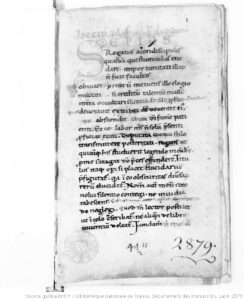Project Blog
Honorius Augustodunensis, his “Elucidarium”

Bibliothèque nationale de France. Département des manuscrits. Latin 2879 (Italian, 12th century) Full facsimile available here
Honorius Augustodunensis wrote a large number of works in addition to the Imago mundi, which forms the center of the present project. Of these, the most influential and best-studied is the Elucidarium.
The Elucidarium is an enclyclopaedic work similar to the Imago mundi. It was also translated into many languages and found immense popularity. However, unlike the latter, it is composed in a dialogue form.
Many manuscripts of the Elucidarium survive, some copied quite late (as this example from the 1450s, preserved in the British Library).
The Elucidarium has been the subject of multiple research projects, as for instance the research project undertaken in 2012-2013 at the University of Kent entitled Spreading the Light: Mapping the Vernacular Elucidarium in Medieval England.
Further reading:
Yves Lefèvre, L’Elucidarium et les lucidaires. Contribution, par l’histoire d’un texte, à l’histoire des croyances religieuses en France au Moyen Âge, Bibliothèque des Écoles françaises d’Athènes et de Rome 180 (Paris: E. de Brocard, 1954)
Valerie I. J. Flint, ‘The Original Text of the Elucidarium of Honorius Augustodunensis from the Twelfth Century English Manuscripts’, Scriptorium 18 (1964), 91-94 (available online)
Ernstpeter Ruhe, Elucidarium und Lucidaires: zur Rezeption des Werks von Honorius Augustodunensis in der Romania und in England, Wissensliteratur im Mittelalter 7 (Wiesbaden, Reichert: 1993)
A fascinating lecture dedicated to the Elucidarium at the College de France by Cédric Giraud can be accessed at https://www.college-de-france.fr/site/michel-zink/seminar-2016-02-03-11h30.htm .
Blog entry by NP

